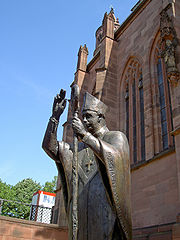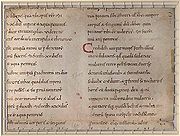
Burchard of Worms
Encyclopedia

Holy Roman Empire
The Holy Roman Empire was a realm that existed from 962 to 1806 in Central Europe.It was ruled by the Holy Roman Emperor. Its character changed during the Middle Ages and the Early Modern period, when the power of the emperor gradually weakened in favour of the princes...
, and author of a Canon law
Canon law (Catholic Church)
The canon law of the Catholic Church, is a fully developed legal system, with all the necessary elements: courts, lawyers, judges, a fully articulated legal code and principles of legal interpretation. It lacks the necessary binding force present in most modern day legal systems. The academic...
collection in twenty books, the "Collectarium canonum" or "Decretum".
Life
Burchard was educated in Coblenz. He was ordained as a deaconDeacon
Deacon is a ministry in the Christian Church that is generally associated with service of some kind, but which varies among theological and denominational traditions...
by Archbishop
Archbishop
An archbishop is a bishop of higher rank, but not of higher sacramental order above that of the three orders of deacon, priest , and bishop...
Willigis of Mainz, and was eventually elevated to primate of Mainz
Mainz
Mainz under the Holy Roman Empire, and previously was a Roman fort city which commanded the west bank of the Rhine and formed part of the northernmost frontier of the Roman Empire...
. In 1000, Emperor Otto III appointed Burchard as the bishop of Worms, an elevation confirmed by Willigis within days. In a biography written shortly after Burchard's death, it was claimed that two priests who had been appointed to the position before Burchard both died within days. The same account also indicates that Worms
Worms, Germany
Worms is a city in Rhineland-Palatinate, Germany, on the Rhine River. At the end of 2004, it had 85,829 inhabitants.Established by the Celts, who called it Borbetomagus, Worms today remains embattled with the cities Trier and Cologne over the title of "Oldest City in Germany." Worms is the only...
was in disrepair, and regularly attacked by both wolves and robbers.
Burchard oversaw the rebuilding of the walls of Worms, the creation of many monasteries
Monastery
Monastery denotes the building, or complex of buildings, that houses a room reserved for prayer as well as the domestic quarters and workplace of monastics, whether monks or nuns, and whether living in community or alone .Monasteries may vary greatly in size – a small dwelling accommodating only...
and churches, and took part in the destruction of the fortifications of Otto I, Duke of Carinthia
Otto I, Duke of Carinthia
Otto , called Otto of Worms, was Duke of Carinthia and Margrave of Verona from 978 to 985 and again from 1002 until his death....
. Duke Otto was believed to be housing criminals, and was an enemy of Burchard's. According to Burchard's biographer, "many limbs were hacked off and many murders occurred on both sides" of the conflict. Burchard adopted a child from the enemy household, who would grow up to become Emperor Conrad II
Conrad II, Holy Roman Emperor
Conrad II was Holy Roman Emperor from 1027 until his death.The son of a mid-level nobleman in Franconia, Count Henry of Speyer and Adelaide of Alsace, he inherited the titles of count of Speyer and of Worms as an infant when Henry died at age twenty...
. After gaining the aid of King Henry II of Bavaria
Bavaria
Bavaria, formally the Free State of Bavaria is a state of Germany, located in the southeast of Germany. With an area of , it is the largest state by area, forming almost 20% of the total land area of Germany...
and engaging in negotiations, Duke Otto's castle was dismantled and rebuilt to become a monastery in honour of St. Paul
Paul of Tarsus
Paul the Apostle , also known as Saul of Tarsus, is described in the Christian New Testament as one of the most influential early Christian missionaries, with the writings ascribed to him by the church forming a considerable portion of the New Testament...
. In 1016, Burchard rebuilt the town's Cathedral of St. Peter
Worms Cathedral
Cathedral of St Peter is a church in Worms, southern Germany. It was the seat of the Catholic Prince-Bishopric of Worms until its extinction in 1800.It is a basilica with four round towers, two large domes, and a choir at each end...
. Burchard also spent time educating students in the cathedral's school.
Burchard died in 1025, leaving to his sister a hair shirt and an iron chain as a memento mori
Memento mori
Memento mori is a Latin phrase translated as "Remember your mortality", "Remember you must die" or "Remember you will die". It names a genre of artistic work which varies widely, but which all share the same purpose: to remind people of their own mortality...
.
Authorship

Along with numerous documents from a variety of sources, including the Old Testament
Old Testament
The Old Testament, of which Christians hold different views, is a Christian term for the religious writings of ancient Israel held sacred and inspired by Christians which overlaps with the 24-book canon of the Masoretic Text of Judaism...
and Augustine of Hippo
Augustine of Hippo
Augustine of Hippo , also known as Augustine, St. Augustine, St. Austin, St. Augoustinos, Blessed Augustine, or St. Augustine the Blessed, was Bishop of Hippo Regius . He was a Latin-speaking philosopher and theologian who lived in the Roman Africa Province...
, Burchard included the Canon Episcopi
Canon Episcopi
The Canon Episcopi is an important document in the history of witchcraft. It is first attested in the Libri de synodalibus causis et disciplinis ecclesiasticis composed by Regino of Prüm around 906, but Regino considered it an older text; he, and later scholars following him, believed it to be from...
in this collection, under the belief that it dated from a bishop's "Council of Anquira" in 314, but no other evidence of this council exists. Because of this inclusion, Burchard has been described as something of a rationalist
Rationalism
In epistemology and in its modern sense, rationalism is "any view appealing to reason as a source of knowledge or justification" . In more technical terms, it is a method or a theory "in which the criterion of the truth is not sensory but intellectual and deductive"...
. As the source of canon law, Burchard's Decretum was supplanted around 1150 by the Decretum Gratiani
Decretum Gratiani
The Decretum Gratiani or Concordia discordantium canonum is a collection of Canon law compiled and written in the 12th century as a legal textbook by the jurist known as Gratian. It forms the first part of the collection of six legal texts, which together became known as the Corpus Juris Canonici...
, a much larger collection that further attempted to reconcile contradictory canon law.
Burchard spent the years 1023 to 1025 promulgating
Promulgation
Promulgation is the act of formally proclaiming or declaring a new statutory or administrative law after its enactment. In some jurisdictions this additional step is necessary before the law can take effect....
Leges et Statuta familiae S. Petri Wormatiensis, a collection of religious laws he endorsed as fair and hoped to see adopted with official approval.
External links
- Biography in the Catholic Encyclopedia
- Translation of The Life of Burchard of Worms
- Opera Omnia by Migne Patrologia Latina with analytical indexes
- Burchard's Lex Familie Wormatiensis
Further reading
- H. Hoffmann and R. Pokorny, Das Dekret des Bischofs Burchard von Worms. Textstufen – Frühe Verbreitung – Vorlagen, Munich 1991.

